Thinking of switching to a battery-powered lawn mower or just need help with your current one? You’re in the right place. Whether you're tired of pulling cords, dealing with gas fumes, or just want something quieter and eco-friendlier, battery-powered mowers are a game-changer. But not all batteries are built the same, and taking care of them properly can mean the difference between years of reliable use or an early trip to the recycling bin. In this guide, we’ll break down everything you need to know—from choosing the right mower batteries to maximizing their lifespan with simple maintenance tips. Ready to keep your lawn looking sharp and your mower running like a champ? Let’s dive in!
Understanding Lawn Mower Batteries: Types and Differences
The various types of lawn mower batteries differ in their performance capabilities and lifespan duration, as well as their maintenance requirements. Differentiating these characteristics allows you to select the appropriate battery match for both your lawn mower and yard dimensions.
Battery type | Description | Maintenance | Cost | Lifespan | |
Lead-Acid | The traditional wet-cell battery, widely used in riding mowers | Moderate (water checks, terminal cleaning) | Low | 2–4 years | |
AGM (Absorbent Glass Mat) | Sealed, spill-proof battery with improved durability | Low | Medium | 4–6 years | |
Lithium-Ion | Lightweight, high-performance battery used in electric push mowers | Very Low (no upkeep) | High | 5–7+ years | |
Gel Cell | Sealed battery designed for deep discharge and rugged use | Low | Medium-High | 4–6 years |
Tired of searching for the right mower battery and parts? WholeToolBox has everything you need from top brands like EGO, Toro, Dewalt, and Ryobi. Power up your mower with parts like replacement batteries, adapters, chargers, and charging docks—all in one place!
How to Choose the Right Battery for Your Lawn Mower
The selection of appropriate lawn mower batteries determines both performance quality and product lifespan. The following factors should guide your decision-making process for selecting the best lawn mower battery.
Mower Type: Different mowers require different batteries. Riding mowers operate with lead-acid or AGM batteries, but push mowers that use electric power mainly run on lithium-ion batteries. Your mower manual holds details about suitable battery selection.
Battery Size: Check that the battery dimension matches the available space in your mower compartment. Measure the battery dimensions, then compare them against the available space inside your mower. The correct battery selection at this point will prevent installation problems.
Voltage: The power output of a mower depends heavily on its operating voltage. The majority of mowers use 12V batteries, yet larger or more powerful mowers that include riding lawn mower motors need higher voltage systems. Check that the voltage level of your battery matches what your mower needs.
Battery Capacity (Ah): The measurement of battery runtime before recharge is expressed through amp-hours (Ah), which determines the capacity of the battery. The runtime duration increases with higher Ah ratings, thus making the device suitable for extensive lawns and extended mowing periods.
Maintenance Needs: Think about how much regular battery maintenance you want to do before purchasing a battery. Lithium-ion batteries require minimal care because they need almost no maintenance compared to lead-acid batteries.
Selecting an appropriate battery will help your mower operate without problems while providing peak efficiency throughout multiple seasons.
Check out this guide on how to winterize lawn mowers, protecting both your mower and its battery during colder months.
Signs Your Lawn Mower Battery Needs Replacing
The ability of lawn mower batteries to power your mower decreases with time. Identifying symptoms soon will help you avoid both difficulties and unplanned equipment shutdowns. These are the typical warning signs that your battery requires replacement:
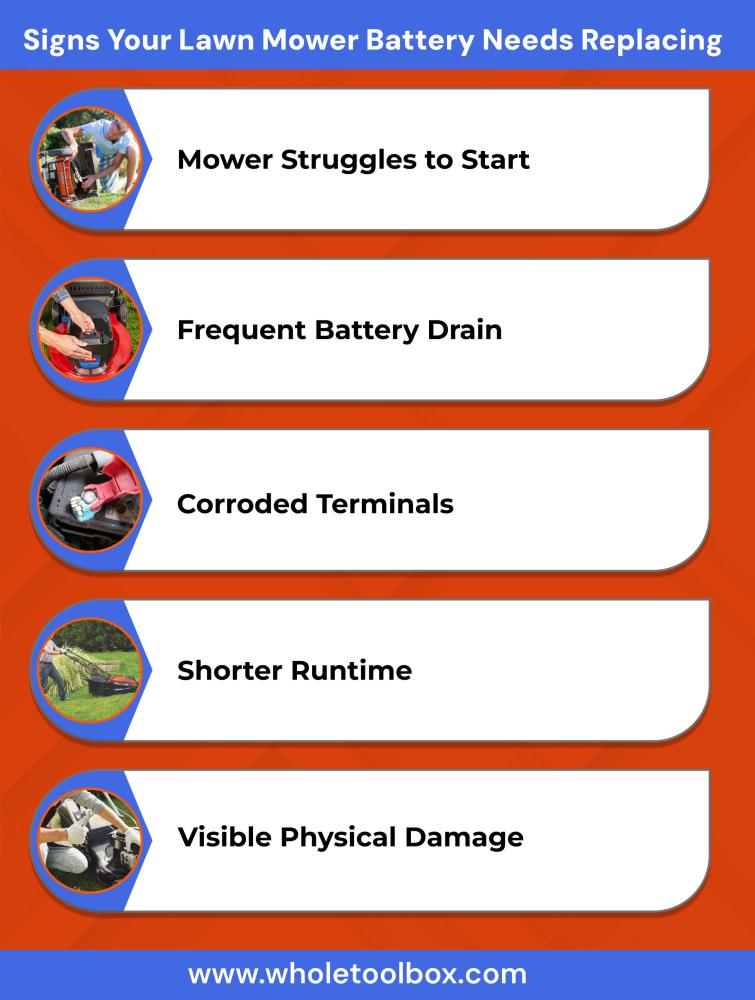
Mower Struggles to Start: A battery that fails to start your mower or takes too long to begin indicates that it has lost its ability to generate sufficient power.
Frequent Battery Drain: Your mower battery shows signs of capacity reduction when it loses power quickly after a complete charge because its ability to maintain a charge has weakened.
Corroded Terminals: The power flow between the battery terminals becomes disrupted by severe terminal corrosion. The presence of persistent corrosion indicates that your battery is approaching its end of life, even though terminal cleaning might provide temporary relief.
Shorter Runtime: The battery needs replacement when it runs for shorter durations than before because its capacity has decreased.
Visible Physical Damage: Serious damage to the battery requires replacement because cracks, bulges or leaks in the battery casing present safety risks.
The replacement of your battery before its total failure will provide uninterrupted mowing performance.
Check out this guide on common lawn mower belt problems and their solutions to find out other problems, like belt-related issues that can mimic battery failure.
Step-by-Step Troubleshooting Battery Issues and Knowing When to Replace
Your lawn mower may suffer from starting difficulties or performance problems because of battery issues. The following guide provides step-by-step instructions to diagnose battery problems and helps users decide when to replace their battery.
Step 1: Mower Won’t Start
Solution: Check the battery charge. Charging the battery to full capacity should be your first step when the charge level is low. Check the terminals for corrosion after charging the battery if the machine fails to start. Use a wire brush to clean the terminals before tightening them securely.
When to Replace: The battery needs replacement when cleaning the terminals and performing a full battery charge does not restore the mower's start function.
Step 2: Short Runtime
Solution: Check that the battery reaches full charge before operating the machine. Check the battery capacity when the mower begins to lose power rapidly. Shorter runtime duration often signals that the battery is losing its strength.
When to Replace: A battery needs replacement when it fails to maintain sufficient power storage capacity for completing an entire mowing operation.
Step 3: Excessive Corrosion or Leakage
Solution: The combination of baking soda and water provides an effective solution for wiping away the battery terminals' corrosion. The battery requires replacement when leakage or severe corrosion damages it beyond a fixable condition.
When to Replace: A battery requires immediate replacement because cracked or leaking cases, along with severe corrosion, pose safety risks.
Step 4: Battery Takes Too Long to Charge
Solution: Check the charging device for proper functionality when your device battery charges at an abnormally slow rate. A defective charger can cause the charging time to become longer than normal.
When to Replace: The battery needs replacement when it continues to charge slowly, even when using a working charger, because this indicates failing cells inside the battery. The battery needs replacement because it will provide better performance.
Step 5: Battery is Warm or Overheats During Use
Solution: The battery overheats or gets too warm during operation because of overcharging or inadequate ventilation, or internal damage.
When to Replace: The battery's failure or short circuit can be detected by overheating. The battery needs replacement when the issue continues after checking ventilation and charging procedures, because further damage or safety risks will occur.
Knowing when to replace the lawn mower battery requires troubleshooting steps that help early detection and efficiency of your machine.
Check out this article on lawn mower troubleshooting made simple to diagnose mower problems, and quick fixes to get your mower running smoothly again.
How to Properly Charge and Store Your Lawn Mower Battery
Your lawn mower battery will stay operational through multiple seasons by using proper charging methods combined with correct storage techniques. The correct practices for lead-acid and AGM, and lithium-ion batteries will significantly improve their performance.
Charging Tips:
Use only the charger that the manufacturer specifically recommends to protect your battery from damage.
Each time you use a cordless electric mower, you should fully charge the battery to maintain its readiness for future operations.
Avoid overcharging. Modern chargers now include automatic shut-off capabilities, which users should use to protect their batteries from damage.
Regular checks and maintenance of electrolyte levels in lead-acid batteries will help maintain proper battery operation.
Storage Tips:
Keep the battery in a shaded area with low temperatures because exposure to sunlight and high or low temperatures will degrade the battery gradually.
Remove the mower battery before long-term storage, such as winter, to stop unnecessary power drain.
The recommended storage method for lithium-ion batteries involves charging them to 50-70% capacity, while lead-acid batteries require a full charge before storage. Regular checks and recharges every 1-2 months will help maintain battery quality.
Before storage, clean the terminals to stop corrosion which will improve contact when you need to use it.
The combination of these basic steps will help extend your lawn mower's cordless battery life while preventing performance problems during your next mowing session.
Maintenance Tips to Extend Lawn Mower Battery Life
A short amount of time spent on lawn mower battery care will produce extended life and optimal machine performance. The longevity of your battery investment depends on regular maintenance, regardless of the battery type you choose between lead-acid, AGM, and lithium-ion.
Clean the Terminals: To maintain battery terminal performance, you should use a wire brush to clean them while applying a baking soda and water solution. Corrosion formation is prevented by this method which protects the power flow.
Secure Connections: Check that the battery cables maintain secure connections. The performance of your battery suffers when connections become loose or when they become contaminated with dirt.
Charge After Each Use: Leave the battery in an inactive state only for brief periods. A lithium-ion battery requires charging right after each use to reach its best operational state.
Avoid Overcharging: A smart charger or a charger with an automatic shut-off feature protects the battery from damage that occurs when charging exceeds its limits.
Store Properly During Off-Season: Place the battery in a dry and cool environment during periods of non-use. Monitoring it regularly for proper recharge will ensure its longevity.
By following routine maintenance, your lawn mower battery will function at peak levels throughout multiple seasons.
Check out these essential tips for extending your lawnmower battery life. Proper care and smart charging habits can significantly boost your battery’s performance and lifespan.
Your lawn mower battery plays a crucial role in keeping your equipment running smoothly and efficiently. From understanding the different types—like lead-acid, AGM, and lithium-ion—to knowing how to choose the right one for your mower, this guide has covered all the essentials. We've also walked through how to spot signs of a failing battery, troubleshoot common issues, and determine when a replacement is needed. Proper charging, correct storage, and routine maintenance can significantly extend your battery’s lifespan and help you avoid unexpected problems during mowing season. By following these tips and keeping an eye on your battery’s performance, you’ll ensure your mower stays in top condition year after year. A little care goes a long way—both for your battery and your lawn.
FAQ’S
What is the voltage of a lawn mower battery?
Most lawn mower batteries are 12V, commonly used in riding and self-propelled mowers. Some smaller or older mowers may use 6V batteries.
How to charge a lawnmower battery with a battery charger?
Connect the charger’s positive (red) clamp to the positive terminal and negative (black) clamp to the negative terminal. Then plug in the charger and let it fully charge the battery.
Are lawn mower batteries 6V or 12V?
Most modern lawn mowers use 12V batteries, especially in riding and self-propelled models. Some older or smaller mowers may use 6V batteries.
How to change a battery in a lawn mower?
Disconnect the spark plug, then remove the battery by disconnecting the terminals (negative first, then positive). Install the new battery by connecting the terminals in reverse order.
How much is a lawn mower battery?
A lawn mower battery typically costs between $30 to $150, depending on the type and brand. Lead-acid batteries are usually more affordable, while lithium-ion batteries are pricier.




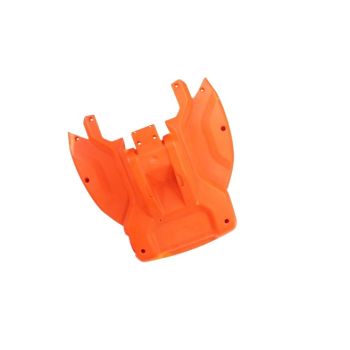
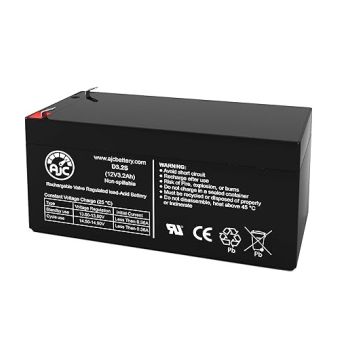
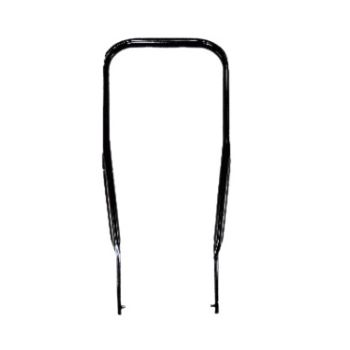
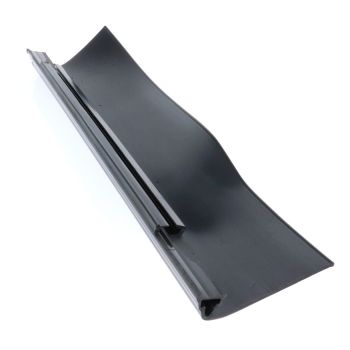
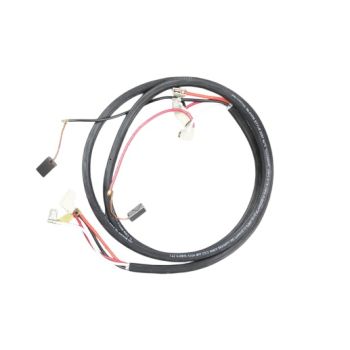
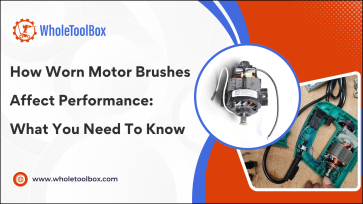




Validate your login